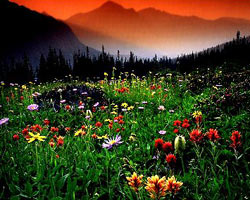Biodiversity
Waterton-Glacier International Peace Park is one of the world's most significant natural areas containing spectacular topography, active glaciers, and unique biotic diversity. The remarkable variety of plants and landscapes bring the scenery to life and provide many attractions for visitors to enjoy the wonderful display of wildflowers.
 These glorious floral displays can be found in the prairies, forests, bogs, alpine meadows, and avalanche chutes. Plants contribute to the visual diversity and splendor of the landscape. Naturalist Karen Schmidt suggests, "Plants also represent a complex universe in and of themselves, a universe we are utterly dependent upon but are only beginning to understand, a universe whose future depends on our ability and our will to uncover its secrets'.
These glorious floral displays can be found in the prairies, forests, bogs, alpine meadows, and avalanche chutes. Plants contribute to the visual diversity and splendor of the landscape. Naturalist Karen Schmidt suggests, "Plants also represent a complex universe in and of themselves, a universe we are utterly dependent upon but are only beginning to understand, a universe whose future depends on our ability and our will to uncover its secrets'.
Glacier's short growing season forces the plants to take advantage of every moment.
Mountain plants have made many adaptations to cope with the seasonal cycles and to grow and reproduce in a brief span of time. To quote Paul Stadley, author of Plants of Glacier National Park, 1926, "The flowers follow quickly upon the retreating snow, and sometimes may be found pushing up their blossoms through its thin edges. In the low elevations there are different blooming periods characteristic of spring, summer, and autumn flowers. Long after flowers have withered many plants become more conspicuous with the ripening of their fruit. Some plants that are inconspicuous in flower are very handsome in fruit. Others are equally attractive at either stage. Several of the plants bear edible fruit, notable the whortleberries, service berries, raspberries, and strawberries."
The variety of vegetation within the Northern Rocky Mountains includes native grassland prairie, aspen park land, mixed conifer forest, sub alpine forest and arctic alpine. Glacier National Park is divided by the continental divide and this results in significant climate and plant community differences. The western half experiences moderate temperatures and is generally moist, with deep snow during winter, and rain and snow during spring and fail. Continental air masses influence the climate on the eastern portion of the park where temperatures are lower and there is less precipitation. At high elevations the extreme climate has limited soil development, succession and plant community development. In contrast, a more moderate climate at lower elevations has allowed the succession of plant communities to develop a forest cover that has been present for thousands of years.
Native plant life and landscapes of Waterton-Glacier International Peace Park are a valuable natural heritage, treasured by the public, preserved for future generations. Park Rangers, Wardens, Naturalists, and Biologists are working with the visiting public to increase the awareness of a land stewardship ethic that is an important component of how we use our National Parks.